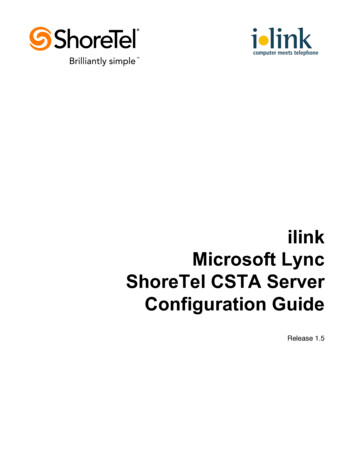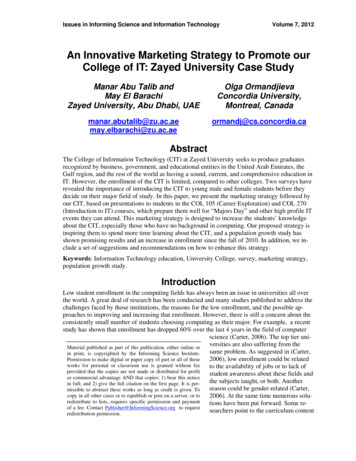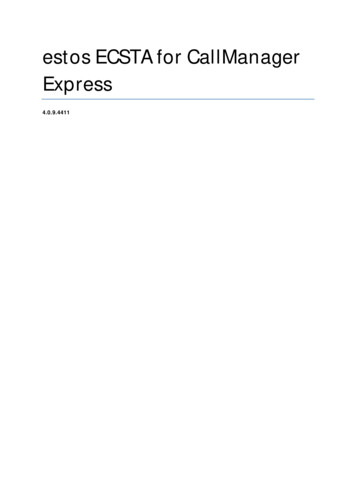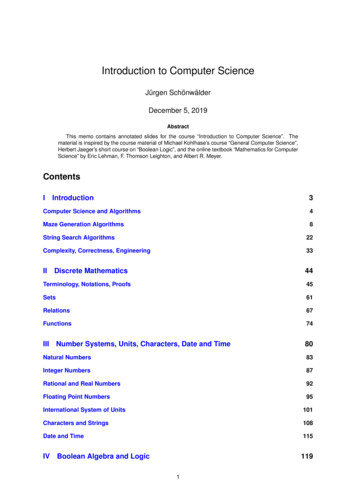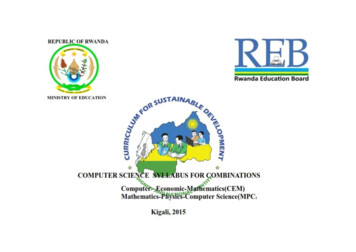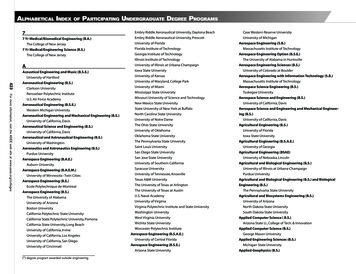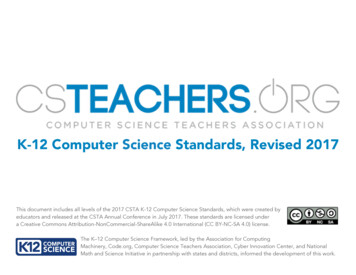
Transcription
K-12 Computer Science Standards, Revised 2017This document includes all levels of the 2017 CSTA K-12 Computer Science Standards, which were created byeducators and released at the CSTA Annual Conference in July 2017. These standards are licensed undera Creative Commons Attribution-NonCommercial-ShareAlike 4.0 International (CC BY-NC-SA 4.0) license.The K–12 Computer Science Framework, led by the Association for ComputingMachinery, Code.org, Computer Science Teachers Association, Cyber Innovation Center, and NationalMath and Science Initiative in partnership with states and districts, informed the development of this work.
About the CSTA K-12 Computer Science StandardsComputer science and the technologies it enables rest at the heart of our economy and the way we live our lives. To be well-educatedcitizens in a computing-intensive world and to be prepared for careers in the 21st century, our students must have a clearunderstanding of the principles and practices of computer science. The CSTA K–12 Computer Science Standards delineate a core setof learning objectives designed to provide the foundation for a complete computer science curriculum and its implementation at theK–12 level. To this end, the CSTA Standards: Introduce the fundamental concepts of computer science to all students, beginning at the elementary school level. Present computer science at the secondary school level in a way that can fulfill a computer science, math, or science graduation credit. Encourage schools to offer additional secondary-level computer science courses that will allow interested students to study facets ofcomputer science in more depth and prepare them for entry into the work force or college. Increase the availability of rigorous computer science for all students, especially those who are members of underrepresented groups.The standards have been written by educators to be coherent and comprehensible to teachers, administrators, and policy makers.Levels 1A, 1B, 2, and 3A are the computer science standards for ALL students. The Level 3B standards are intended for students whowish to pursue the study of computer science in high school beyond what is required for all students (specialty or elective courses).Connection to the K-12 Computer Science FrameworkThe K–12 Computer Science Framework (k12cs.org) provides overarching, high-level guidance per grade bands, while the standardsprovide detailed, measurable student performance expectations. The Framework was considered as a primary input for the standardsdevelopment process.The CSTA Standards Revision Task Force crafted standards by combining concept statements and practices from the Framework. Italso used descriptive material from the Framework when writing examples and clarifying statements to accompany the standards.Concepts1.2.3.4.5.Computing SystemsNetworks and the InternetData and AnalysisAlgorithms and ProgrammingImpacts of ComputingPractices1. Fostering an Inclusive ComputingCulture2. Collaborating Around Computing3. Recognizing and DefiningComputational Problems4. Developing and Using Abstractions5. Creating Computational Artifacts6. Testing and Refining ComputationalArtifacts7. Communicating About Computing
Level 1A: Grades K-2 (Ages 5-7)Computing SystemsIdentifierStandard and Descriptive StatementSubconceptPractice1A-CS-01Select and operate appropriate software to perform a variety of tasks, and recognize thatusers have different needs and preferences for the technology they use.Devices1.1Hardware &Software7.2Troubleshooting6.2, 7.2Cybersecurity7.3People use computing devices to perform a variety of tasks accurately and quickly. Students should be able toselect the appropriate app/program to use for tasks they are required to complete. For example, if studentsare asked to draw a picture, they should be able to open and use a drawing app/program to complete thistask, or if they are asked to create a presentation, they should be able to open and use presentation software.In addition, with teacher guidance, students should compare and discuss preferences for software with thesame primary functionality. Students could compare different web browsers or word processing, presentation,or drawing programs.1A-CS-02Use appropriate terminology in identifying and describing the function of common physicalcomponents of computing systems (hardware).A computing system is composed of hardware and software.Hardware consists of physicalcomponents.Students should be able to identify and describe the function of external hardware, such asdesktop computers, laptop computers, tablet devices, monitors, keyboards, mice, and printers.1A-CS-03Describe basic hardware and software problems using accurate terminology.Problems with computing systems have different causes. Students at this level do not need to understandthose causes, but they should be able to communicate a problem with accurate terminology (e.g., when anapp or program is not working as expected, a device will not turn on, the sound does not work, etc.). Ideally,students would be able to use simple troubleshooting strategies, including turning a device off and on toreboot it, closing and reopening an app, turning on speakers, or plugging in headphones. These are,however, not specified in the standard, because these problems may not occur.Networks and the Internet1A-NI-04Explain what passwords are and why we use them, and use strong passwords to protectdevices and information from unauthorized access.Learning to protect one's device or information from unwanted use by others is an essential first step inlearning about cybersecurity. Students are not required to use multiple strong passwords. They shouldappropriately use and protect the passwords they are required to use.
Data and Analysis1A-DA-05Store, copy, search, retrieve, modify, and delete information using a computing device anddefine the information stored as data.Storage4.2All information stored and processed by a computing device is referred to as data. Data can be images, textdocuments, audio files, software programs or apps, video files, etc. As students use software to completetasks on a computing device, they will be manipulating data.1A-DA-06Collect and present the same data in various visual formats.CollectionThe collection and use of data about the world around them is a routine part of life and influences how people Visualization &live. Students could collect data on the weather, such as sunny days versus rainy days, the temperature at theTransformation7.1, 4.4Identify and describe patterns in data visualizations, such as charts or graphs, to makepredictions.Inference &Models4.1Algorithms4.4beginning of the school day and end of the school day, or the inches of rain over the course of a storm.Students could count the number of pieces of each color of candy in a bag of candy, such as Skittles orM&Ms. Students could create surveys of things that interest them, such as favorite foods, pets, or TV shows,and collect answers to their surveys from their peers and others. The data collected could then be organizedinto two or more visualizations, such as a bar graph, pie chart, or pictograph.1A-DA-07Data can be used to make inferences or predictions about the world. Students could analyze a graph or piechart of the colors in a bag of candy or the averages for colors in multiple bags of candy, identify the patternsfor which colors are most and least represented, and then make a prediction as to which colors will have mostand least in a new bag of candy. Students could analyze graphs of temperatures taken at the beginning of theschool day and end of the school day, identify the patterns of when temperatures rise and fall, and predict ifthey think the temperature will rise or fall at a particular time of the day, based on the pattern observed.Algorithms and Programming1A-AP-08Model daily processes by creating and following algorithms (sets of step-by-stepinstructions) to complete tasks.Composition is the combination of smaller tasks into more complex tasks. Students could create and followalgorithms for making simple foods, brushing their teeth, getting ready for school, participating in clean-uptime.
1A-AP-09Model the way programs store and manipulate data by using numbers or other symbols torepresent gramDevelopment5.1, 7.2ProgramDevelopment7.3Information in the real world can be represented in computer programs. Students could use thumbs up/downas representations of yes/no, use arrows when writing algorithms to represent direction, or encode anddecode words using numbers, pictographs, or other symbols to represent letters or words.1A-AP-10Develop programs with sequences and simple loops, to express ideas or address aproblem.Programming is used as a tool to create products that reflect a wide range of interests. Control structuresspecify the order in which instructions are executed within a program.Sequences are the order of instructions in a program. For example, if dialogue is not sequenced correctlywhen programming a simple animated story, the story will not make sense. If the commands to program arobot are not in the correct order, the robot will not complete the task desired.Loops allow for the repetition of a sequence of code multiple times. For example, in a program to show thelife cycle of a butterfly, a loop could be combined with move commands to allow continual but controlledmovement of the character.1A-AP-11Decompose (break down) the steps needed to solve a problem into a precise sequence ofinstructions.Decomposition is the act of breaking down tasks into simpler tasks. Students could break down the stepsneeded to make a peanut butter and jelly sandwich, to brush their teeth, to draw a shape, to move a characteracross the screen, or to solve a level of a coding app.1A-AP-12Develop plans that describe a program’s sequence of events, goals, and expectedoutcomes.Creating a plan for what a program will do clarifies the steps that will be needed to create a program and canbe used to check if a program is correct. Students could create a planning document, such as a story map, astoryboard, or a sequential graphic organizer, to illustrate what their program will do. Students at this stagemay complete the planning process with help from their teachers.1A-AP-13Give attribution when using the ideas and creations of others while developing programs.Using computers comes with a level of responsibility. Students should credit artifacts that were created byothers, such as pictures, music, and code. Credit could be given orally, if presenting their work to the class, orin writing or orally, if sharing work on a class blog or website. Proper attribution at this stage does not requirea formal citation, such as in a bibliography or works cited document.
1A-AP-14Debug (identify and fix) errors in an algorithm or program that includes sequences andsimple lture7SocialInteractions2.1Safety Law &Ethics7.3Algorithms or programs may not always work correctly. Students should be able to use various strategies, suchas changing the sequence of the steps, following the algorithm in a step-by-step manner, or trial and error tofix problems in algorithms and programs.1A-AP-15Using correct terminology, describe steps taken and choices made during the iterativeprocess of program development.At this stage, students should be able to talk or write about the goals and expected outcomes of theprograms they create and the choices that they made when creating programs. This could be done usingcoding journals, discussions with a teacher, class presentations, or blogs.Impacts of Computing1A-IC-16Compare how people live and work before and after the implementation or adoption ofnew computing technology.Computing technology has positively and negatively changed the way people live and work. In the past, ifstudents wanted to read about a topic, they needed access to a library to find a book about it. Today,students can view and read information on the Internet about a topic or they can download e-books about itdirectly to a device. Such information may be available in more than one language and could be read to astudent, allowing for great accessibility.1A-IC-17Work respectfully and responsibly with others online.Online communication facilitates positive interactions, such as sharing ideas with many people, but the publicand anonymous nature of online communication also allows intimidating and inappropriate behavior in theform of cyberbullying. Students could share their work on blogs or in other collaborative spaces online, takingcare to avoid sharing information that is inappropriate or that could personally identify them to others.Students could provide feedback to others on their work in a kind and respectful manner and could tell anadult if others are sharing things they should not share or are treating others in an unkind or disrespectfulmanner on online collaborative spaces.1A-IC-18Keep login information private, and log off of devices appropriately.People use computing technology in ways that can help or hurt themselves or others. Harmful behaviors, suchas sharing privateinformation and leaving public devices logged in should be recognized and avoided.
Level 1B: Grades 3-5 (Ages 8-11)Computing SystemsIdentifierStandard and Descriptive StatementSubconceptPractice1B-CS-01Describe how internal and external parts of computing devices function to form a system.Devices7.2Hardware &Software4.4Troubleshooting6.2Computing devices often depend on other devices or components. For example, a robot depends on aphysically attached light sensor to detect changes in brightness, whereas the light sensor depends on therobot for power. Keyboard input or a mouse click could cause an action to happen or information to bedisplayed on a screen; this could only happen because the computer has a processor to evaluate what ishappening externally and produce corresponding responses. Students should describe how devices andcomponents interact using correct terminology.1B-CS-02Model how computer hardware and software work together as a system to accomplishtasks.In order for a person to accomplish tasks with a computer, both hardware and software are needed. At thisstage, a model should only include the basic elements of a computer system, such as input, output, processor,sensors, and storage. Students could draw a model on paper or in a drawing program, program an animationto demonstrate it, or demonstrate it by acting this out in some way.1B-CS-03Determine potential solutions to solve simple hardware and software problems usingcommon troubleshooting strategies.Although computing systems may vary, common troubleshooting strategies can be used on all of them.Students should be able to identify solutions to problems such as the device not responding, no power, nonetwork, app crashing, no sound, or password entry not working. Should errors occur at school, the goalwould be that students would use various strategies, such as rebooting the device, checking for power,checking network availability, closing and reopening an app, making sure speakers are turned on orheadphones are plugged in, and making sure that the caps lock key is not on, to solve these problems, whenpossible.
Networks and the Internet1B-NI-04Model how information is broken down into smaller pieces, transmitted as packets throughmultiple devices over networks and the Internet, and reassembled at the destination.Information is sent and received over physical or wireless paths. It is broken down into smaller pieces calledpackets, which are sent independently and reassembled at the destination. Students should demonstrate theirunderstanding of this flow of information by, for instance, drawing a model of the way packets are transmitted,programming an animation to show how packets are transmitted, or demonstrating this through an unpluggedactivity which has them act it out in some way.1B-NI-05Discuss real-world cybersecurity problems and how personal information can be protected.NetworkCommunication& tion &Transformation7.1Inference &Models7.1Just as we protect our personal property offline, we also need to protect our devices and the informationstored on them. Information can be protected using various security measures. These measures can bephysical and/or digital. Students could discuss or use a journaling or blogging activity to explain, orally or inwriting, about topics that relate to personal cybersecurity issues. Discussion topics could be based on currentevents related to cybersecurity or topics that are applicable to students, such as the necessity of backing updata to guard against loss, how to create strong passwords and the importance of not sharing passwords, orwhy we should install and keep anti-virus software updated to protect data and systems.Data and Analysis1B-DA-06Organize and present collected data visually to highlight relationships and support a claim.Raw data has little meaning on its own. Data is often sorted or grouped to provide additional clarity.Organizing data can make interpreting and communicating it to others easier. Data points can be clustered bya number of commonalities. The same data could be manipulated in different ways to emphasize particularaspects or parts of the data set. For example, a data set of sports teams could be sorted by wins, pointsscored, or points allowed, and a data set of weather information could be sorted by high temperatures, lowtemperatures, or precipitation.1B-DA-07Use data to highlight or propose cause-and-effect relationships, predict outcomes, orcommunicate an idea.The accuracy of data analysis is related to how realistically data is represented. Inferences or predictions basedon data are less likely to be accurate if the data is not sufficient or if the data is incorrect in some way.Students should be able to refer to data when communicating an idea. For example, in order to explore therelationship between speed, time, and distance, students could operate a robot at uniform speed, and atincreasing time intervals to predict how far the robot travels at that speed. In order to make an accurateprediction, one or two attempts of differing times would not be enough. The robot may also collect
temperature data from a sensor, but that data would not be relevant for the task. Students must also makeaccurate measurements of the distance the robot travels in order to develop a valid prediction. Students couldrecord the temperature at noon each day as a basis to show that temperatures are higher in certain months ofthe year. If temperatures are not recorded on non-school days or are recorded incorrectly or at different timesof the day, the data would be incomplete and the ideas being communicated could be inaccurate. Studentsmay also record the day of the week on which the data was collected, but this would have no relevance towhether temperatures are higher or lower. In order to have sufficient and accurate data on which tocommunicate the idea, students might want to use data provided by a governmental weather agency.Algorithms and Programming1B-AP-08Compare and refine multiple algorithms for the same task and determine which is the mostappropriate.Algorithms6.3, 3.3Variables5.2Control5.2Different algorithms can achieve the same result, though sometimes one algorithm might be most appropriatefor a specific situation. Students should be able to look at different ways to solve the same task and decidewhich would be the best solution. For example, students could use a map and plan multiple algorithms to getfrom one point to another. They could look at routes suggested by mapping software and change the route tosomething that would be better, based on which route is shortest or fastest or would avoid a problem.Students might compare algorithms that describe how to get ready for school. Another example might be towrite different algorithms to draw a regular polygon and determine which algorithm would be the easiest tomodify or repurpose to draw a different polygon.1B-AP-09Create programs that use variables to store and modify data.Variables are used to store and modify data. At this level, understanding how to use variables is sufficient. Forexample, students may use mathematical operations to add to the score of a game or subtract from thenumber of lives available in a game. The use of a variable as a countdown timer is another example.1B-AP-10Create programs that include sequences, events, loops, and conditionals.Control structures specify the order (sequence) in which instructions are executed within a program and can becombined to support the creation of more complex programs. Events allow portions of a program to runbased on a specific action. For example, students could write a program to explain the water cycle and when aspecific component is clicked (event), the program would show information about that part of the water cycle.Conditionals allow for the execution of a portion of code in a program when a certain condition is true. Forexample, students could write a math game that asks multiplication fact questions and then uses a conditionalto check whether or not the answer that was entered is correct. Loops allow for the repetition of a sequence ofcode multiple times. For example, in a program that produces an animation about a famous historicalcharacter, students could use a loop to have the character walk across the screen as they introducethemselves.
1B-AP-11Decompose (break down) problems into smaller, manageable subproblems to facilitate theprogram development nt1.1, 5.1ProgramDevelopment5.2, 7.3ProgramDevelopment6.1, 6.2Decomposition is the act of breaking down tasks into simpler tasks. For example, students could create ananimation by separating a story into different scenes. For each scene, they would select a background, placecharacters, and program actions.1B-AP-12Modify, remix, or incorporate portions of an existing program into one's own work, todevelop something new or add more advanced features.Programs can be broken down into smaller parts, which can be incorporated into new or existing programs.For example, students could modify prewritten code from a single-player game to create a two-player gamewith slightly different rules, remix and add another scene to an animated story, use code to make a ballbounce from another program in a new basketball game, or modify an image created by another student.1B-AP-13Use an iterative process to plan the development of a program by including others'perspectives and considering user preferences.Planning is an important part of the iterative process of program development. Students outline key features,time and resource constraints, and user expectations. Students should document the plan as, for example, astoryboard, flowchart, pseudocode, or story map.1B-AP-14Observe intellectual property rights and give appropriate attribution when creating orremixing programs.Intellectual property rights can vary by country but copyright laws give the creator of a work a set of rights thatprevents others from copying the work and using it in ways that they may not like. Students should identifyinstances of remixing, when ideas are borrowed and iterated upon, and credit the original creator. Studentsshould also consider common licenses that place limitations or restrictions on the use of computationalartifacts, such as images and music downloaded from the Internet. At this stage, attribution should be writtenin the format required by the teacher and should always be included on any programs shared online.1B-AP-15Test and debug (identify and fix errors) a program or algorithm to ensure it runs asintended.As students develop programs they should continuously test those programs to see that they do what wasexpected and fix (debug), any errors. Students should also be able to successfully debug simple errors inprograms created by others.
1B-AP-16Take on varying roles, with teacher guidance, when collaborating with peers during thedesign, implementation, and review stages of program t7.2Culture3.1Culture1.2Collaborative computing is the process of performing a computational task by working in pairs or on teams.Because it involves asking for the contributions and feedback of others, effective collaboration can lead tobetter outcomes than working independently. Students should take turns in different roles during programdevelopment, such as note taker, facilitator, program tester, or “driver” of the computer.1B-AP-17Describe choices made during program development using code comments, presentations,and demonstrations.People communicate about their code to help others understand and use their programs. Another purpose ofcommunicating one's design choices is to show an understanding of one's work. These explanations couldmanifest themselves as in-line code comments for collaborators and assessors, or as part of a summativepresentation, such as a code walk-through or coding journal.Impacts of Computing1B-IC-18Discuss computing technologies that have changed the world, and express how thosetechnologies influence, and are influenced by, cultural practices.New computing technology is created and existing technologies are modified for many reasons, including toincrease their benefits, decrease their risks, and meet societal needs. Students, with guidance from theirteacher, should discuss topics that relate to the history of technology and the changes in the world due totechnology. Topics could be based on current news content, such as robotics, wireless Internet, mobilecomputing devices, GPS systems, wearable computing, or how social media has influenced social and politicalchanges.1B-IC-19Brainstorm ways to improve the accessibility and usability of technology products for thediverse needs and wants of users.The development and modification of computing technology are driven by people’s needs and wants and canaffect groups differently. Anticipating the needs and wants of diverse end users requires students topurposefully consider potential perspectives of users with different backgrounds, ability levels, points of view,and disabilities. For example, students may consider using both speech and text when they wish to conveyinformation in a game. They may also wish to vary the types of programs they create, knowing that noteveryone shares their own tastes.
1B-IC-20Seek diverse perspectives for the purpose of improving computational artifacts.Computing provides the possibility for collaboration and sharing of ideas and allows the benefit of diverseperspectives. For example, students could seek feedback from other groups in their class or students atanother grade level. Or, with guidance from their teacher, they could use video conferencing tools or otheronline collaborative spaces, such as blogs, wikis, forums, or website comments, to gather feedback fromindividuals and groups about programming projects.1B-IC-21Use public domain or creative commons media, and refrain from copying or using materialcreated by others without permission.SocialInteractions1.1Safety Law &Ethics7.3Ethical complications arise from the opportunities provided by computing. The ease of sending and receivingcopies of media on the Internet, such as video, photos, and music, creates the opportunity for unauthorizeduse, such as online piracy, and disregard of copyrights. Students should consider the licenses oncomputational artifacts that they wish to use. For example, the license on a downloaded image or audio filemay have restrictions that prohibit modification, require attribution, or prohibit use entirely.Level 2: Grades 6-8 (Ages 11-14)Computing SystemsIdentifierStandard and Descriptive StatementSubconceptPractice2-CS-01Recommend improvements to the design of computing devices, based on an analysis ofhow users interact with the devices.Devices3.3Hardware &Software5.1The study of human–computer interaction (HCI) can improve the design of devices, including both hardwareand software. Students should make recommendations for existing devices (e.g., a laptop, phone, or tablet) ordesign their own components or interface (e.g., create their own controllers). Teachers can guide students toconsider usability through several lenses, including accessibility, ergonomics, and learnability. For example,assistive devices provide capabilities such as scanning written information and converting it to speech.2-CS-02Design projects that combine hardware and software components to collect and exchangedata.Collecting and exchanging data involves input, output, storage, and processing. When possible, studentsshould select the hardware and software components for their project designs by considering factors such asfunctionality, cost, size, speed, accessibility, and aesthetics. For example, components for a mobile app couldinclude accelerometer, GPS, and speech recognition. The choice of a device that connects wirelessly througha Bluetooth connection versus a physical USB connection involves a tradeoff between mobility and the needfor an additional power source for the wireless device.
2-CS-03Systematically identify and fix problems with computing devices and their components.Troubleshooting6.2NetworkCommunication& ce a computing device may interact with interconnected devices within a system, problems may not be dueto the specific computing device itself but to devices connected to it. Just as pilots use checklists totroubleshoot problems with aircraft systems, students should use a similar, structured process to troubleshootproblems with computing systems and ensure that potential solutions ar
Levels 1A, 1B, 2, and 3A are the computer science standards for ALL students. The Level 3B standards are intended for students who wish to pursue the study of computer science in high school beyond what is required for all students (specialty or elective courses). Connection to the K-12 Computer Science Framework The K-12 Computer Science .
